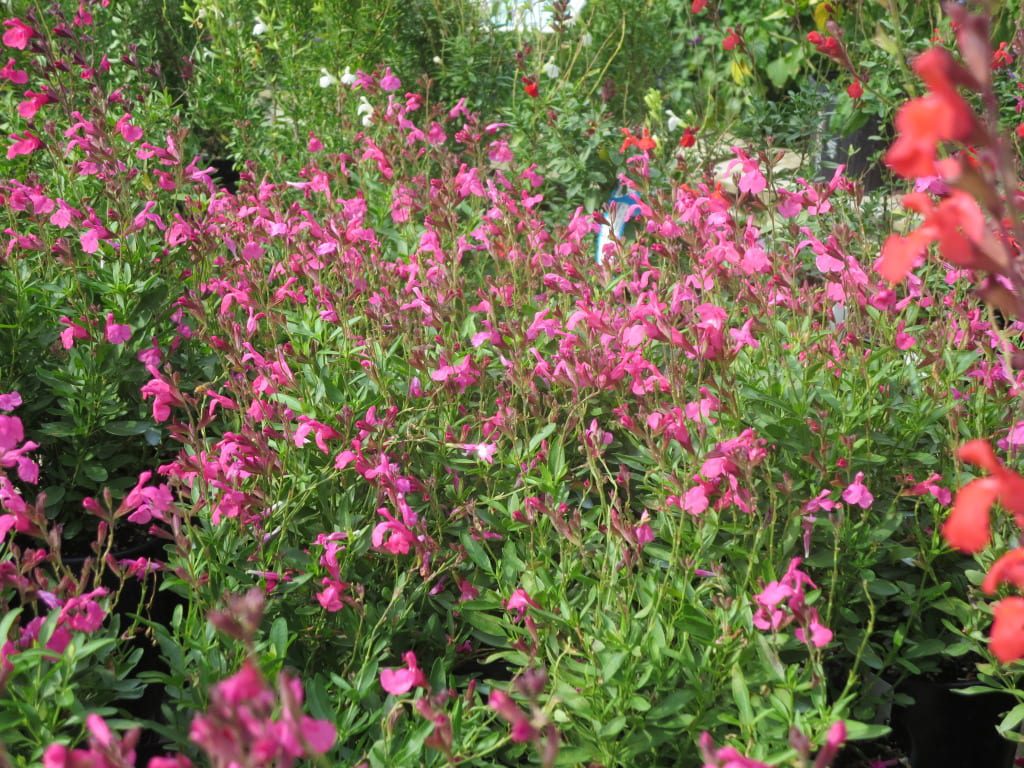

Fall Pruning Tasks for Pollinator Prep
Cut back tropical milkweed 3 times a year. It grows fast and will recover nicely, and if you cut it back at the right times, the blooms will coincide with pollinator migrations. Cutting back tropical milkweed is essential to the health of monarch butterflies. Cutting it back prevents monarchs from establishing winter colonies and also prevent the spread of OE, by helping to eliminate any OE spores that may be left on the plant. (Plant more native milkweeds when you can find them!)
- Cut back after the spring pollinator migration
- Cut back end of July – 1st week of August
- Cut back after the fall pollinator migration (mid November)
Perennials should also be cut back around the end of July through the 2nd week of August. (Maybe towards the latter this year because of the unrelenting heat.) Salvias, lantana, firebush, anisacanthus, agastache, Blue Mistflower, etc… are some examples of plants that can get rejuvenated with a shear. Cut them back by about 1/3 and offer some fertilizer along with a good, deep watering. The trim will encourage new growth and blooms in time for the fall pollinators.
Sometimes gardeners overlook this task. Perhaps there are still blooms on your perennials that are lingering over from summer. I know it can be tough to cut them off, but trust me on this one. You will be rejuvenating your tired plant and it will reward you with even more flowers that will extend through fall.
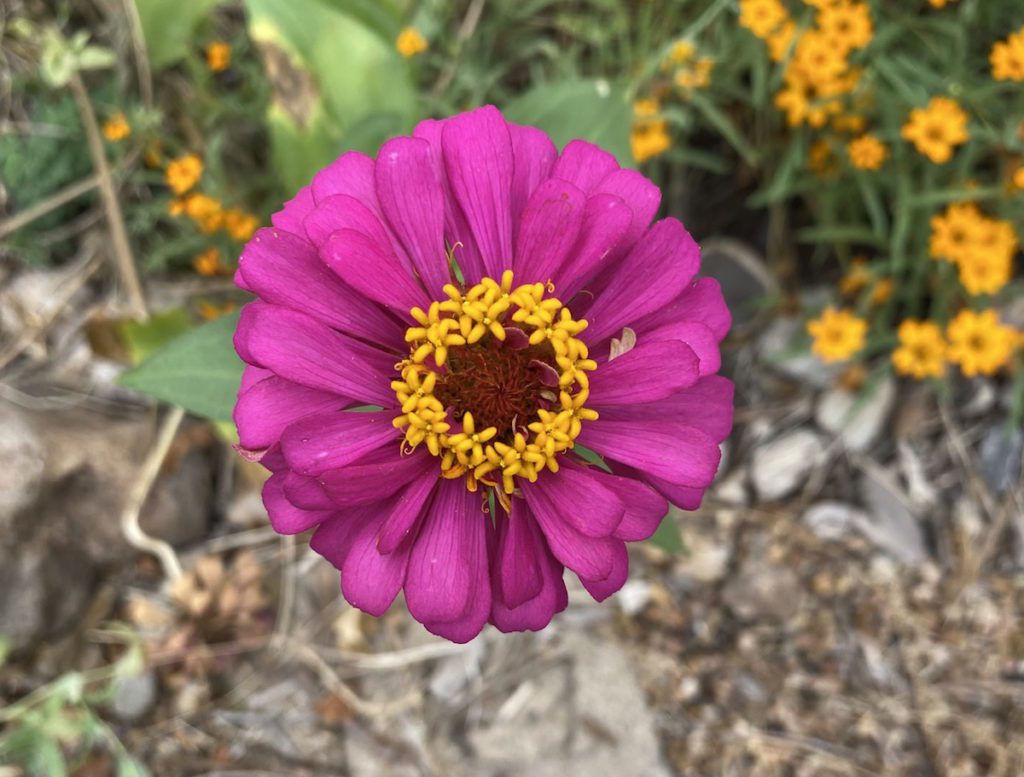

Warm Weather Annual Seeds for Early Fall Pollinators
Now is the time to start seeds of some of your early fall annuals. Laura Jarvis of The Butterfly Landing recently held a Pollinators 102 class at our Bandera Rainbow Gardens location. She advised starting some seeds now in order to be able to get them into your early fall gardens. If you haven’t visited The Butterfly Landing site yet, I highly advise you to check out all of the information Laura Jarvis shares on her Facebook page. She is a wealth of knowledge when it comes to pollinators and she is always so gracious and willing to share so others can learn.
One of Laura’s recommendations were seeds of zinnias. Profusion varieties, as well as Tetra varieties, pictured above, are a favorite. Zinnias are full of nectar. Notice those tiny yellow flowers in the center? That’s what holds the nectar for pollinators; you are sure to have a lot of pollinator activity on these. Marigolds, Mexican sunflowers (Torch variety is best), regular sunflowers, petunias, fennel and parsley seeds can all be started now as well. The bonus to planting marigolds in fall is that they are not as susceptible to spider mites as they are when planted spring – summer.
The key to success with these seed plantings is that they need moisture, not so easy to come by with this extreme heat and drought we are experiencing this year. While the above mentioned seeds can be direct seeded into the garden, you will need to make sure that they are receiving adequate water while they grow. If you think it would be easier keeping your seedlings watered in 4″ pots for awhile, we’d advise planting them in a tray of those and setting them in a shady spot outside. Allow them to grow their first set of true leaves and develop a root system, then you can move them to their permanent spot in gardens once the weather breaks.
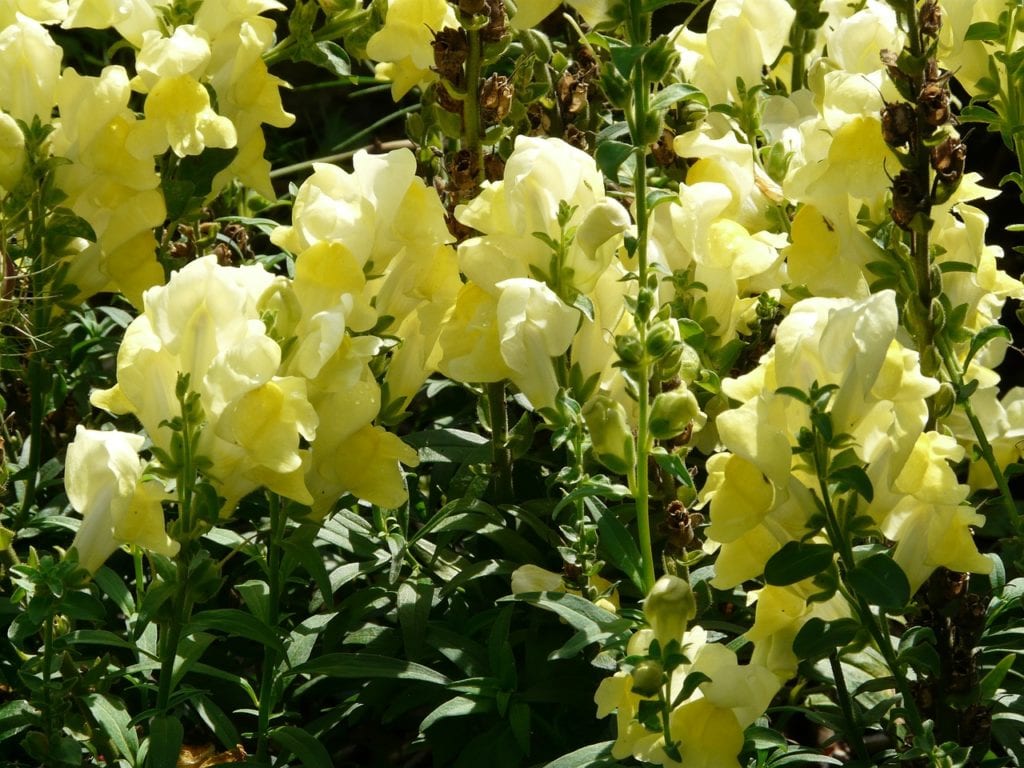

Cool Weather Annual Seeds for Fall Pollinators
Late August – September. Generally we begin to start cool weather annual seeds towards the middle of August but this year, with the extended heat, you might want to push it back to when the heat breaks (most likely end of August or in September). Grow seedlings in shady areas outside and keep the top 2″ of soil moist. Once they achieve their first true set of leaves, they can be moved to where they receive morning sun and afternoon shade.
Just watch the temperatures. If extreme heat continues longer than expected, they may require the shade a little longer. Cool weather annuals for pollinators to try are: Try snapdragons (pictured), violas, pansies, stock. These seeds are small and can be difficult to start, so you may want to just opt for transplants in October instead.
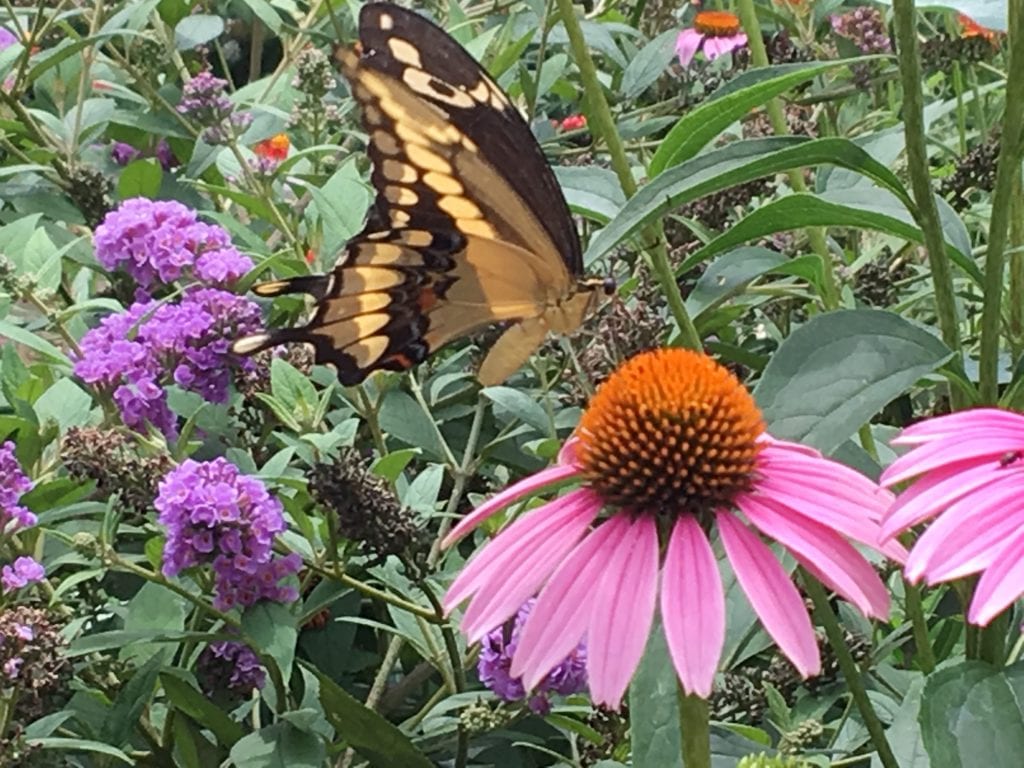

October – December. Wildflower seeds are also highly recommended for pollinators. These, along with perennial native milkweed seeds, get planted a little bit later. October through December is the period of time for planting these seeds. We’ll have your wildflower mixes available in plenty of time for planting during the correct month. However, now might be a good time to stake out or clear out an area that you can allow the seeds to grow undisturbed and without competition from grass and other plants. Planted in fall, these seeds will be able to undergo the natural cold stratification process needed in order for them to germinate.
Purple Coneflowers, or echinacea, are another top choice for Laura. She says they bring in lots of pollinators; their centers offer just enough space for hummingbirds to poke their proboscis in and get a sip. October through December is also the right time for planting echinacea and echinacea seed. They are difficult to find sometimes during that time of year sp if you see them then, buy them.
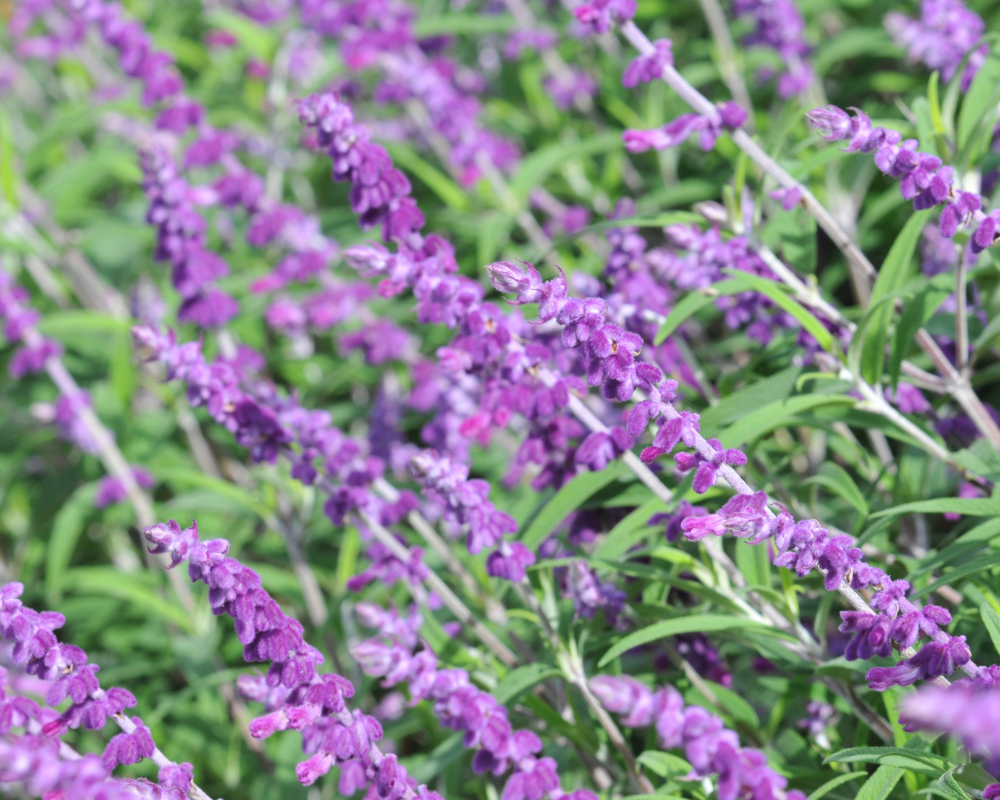

Fall Blooming Perennials to Attract Pollinators
It’s still blazing hot, so transplants will struggle if planted in this heat. I do want to make sure you know a couple of plants to keep an eye out for when the heat finally breaks. If you want to use your Bonus Bucks to purchase some of these but don’t want to plant until later, keep them in a shady area and make sure they are thoroughly watered. I mean, check on them every single day! Once the heat lets up a little, these beauties can go into your gardens and start bringing in the butterflies.
These pollinator attracting perennials put on a great fall show: Fall Aster, Sennas (late fall bloomers, stunning!), Mexican Bush Sage (pictured), Shrimp Plant, Autumn Sage, and Goldenrod, and Duranta usually puts on another round of blooms in fall.
I mainly wanted to offer you a loose schedule for starting pollinator seeds or plants in order to not be left without nectar plants for the fall migration. You’ll spend a little more time watering and babying your new plant starts, but if you wait too long to get your seeds going or to buy your plants, it will be impossible to catch up. Best of luck!
~The Happy Gardener, Lisa Mulroy

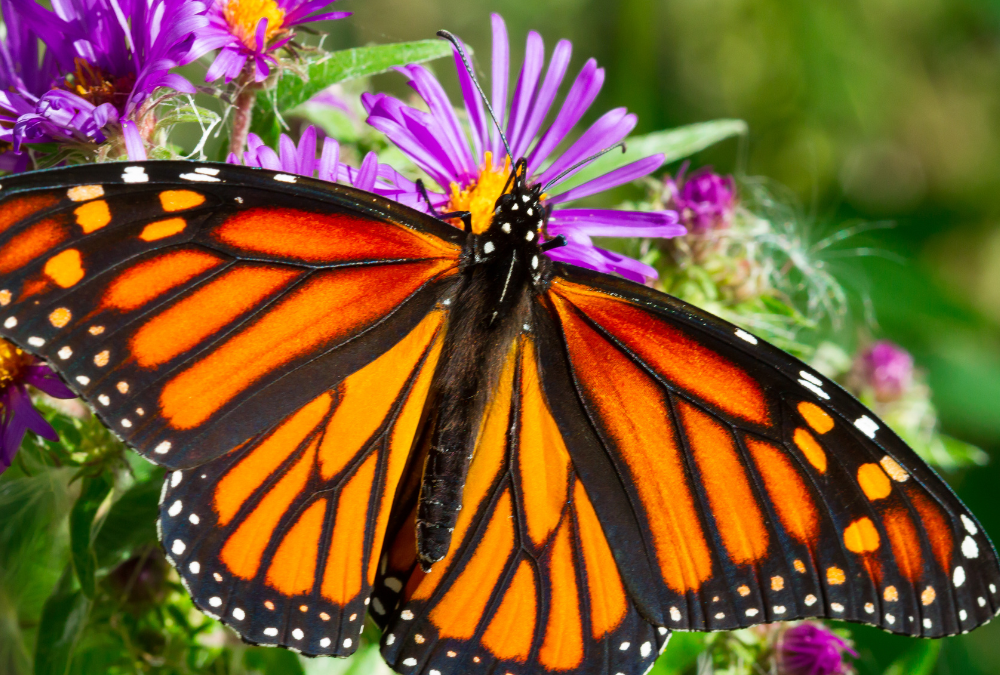
Should Silverado sage be sheared back too?
Hi Sarah,
Texas Sage is best pruned back in late winter/very early spring. This way you do not affect any potential flowering. At that time, you can prune it to whatever height you’d like.
Also, what kind of fertilizer is good for the sages, salvias, lantana…?
Hi Sarah,
A general, all purpose fertilizer with NPK of 10-10-10 or 20-20-20 is fine. These types of plants do not need a lot of it. Another way to easily feed, and maybe better feed would be to add an inch of aged compost around the plants. They appreciate the organic matter more than actual fertilizer.
My two milkweed plants are about 12” tall and have not bloomed. Should I still cut them back?
Are these fairly new plants and are these tropical milkweed? If so, I wouldn’t cut them now. Let them grow through the fall monarch migration and then cut them down to the ground then. Cut them back again after the spring migration and then next summer you will most likely be ready to prune them back by about a third or half to rejuvenate them for the upcoming fall.
Your milkweed, if tropical, will most likely start blooming when it gains another 12″-18″. Also, make sure they are getting enough water through this drought. Recent rains will help a growth spurt.
How far back do you cut back Tropical Milkweed? To the ground?
After the fall monarch migration, yes, you can cut it to the ground. I like to do this again after the spring migration. (2 major prunings a year at least.) Right now, for a summer prune to get ready for fall on established plants, I’d cut back by about a third or a half. Tropical Milkweed grows fast and recovers quickly from pruning. You should be in good shape for the fall pollinator migration. Water well after pruning.